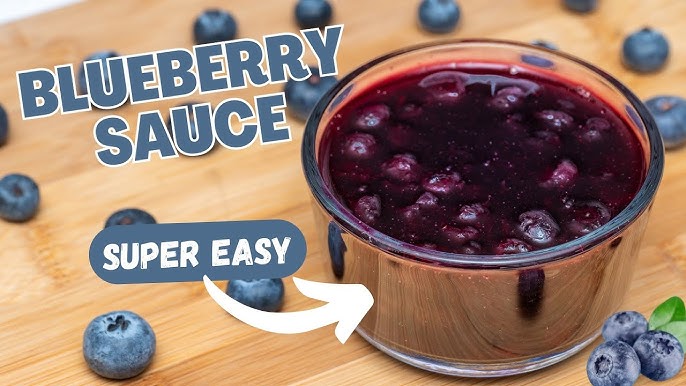Blueberry Sauce Recipe: Blueberry sauce is one of those delightful kitchen staples that seems to make everything better. Whether you’re drizzling it over pancakes, spooning it onto cheesecake, or swirling it into yogurt, this sweet and tangy sauce elevates ordinary dishes to something extraordinary. Unlike store-bought versions, homemade blueberry sauce is fresher, tastier, and can be tailored to your specific preferences—whether you like it thick and chunky or smooth and syrupy.
The beauty of blueberry sauce lies in its versatility. It complements both sweet and savory dishes and takes just a few simple ingredients to make. Plus, it’s a great way to use up an abundance of fresh or frozen blueberries. With this step-by-step guide, you’ll master making blueberry sauce from scratch—without any artificial flavors or preservatives. Ready to get started? Let’s dive in.
Ingredients Needed for Blueberry Sauce
Before you roll up your sleeves, you’ll need to gather your ingredients. Fortunately, this recipe is wonderfully simple and flexible, so you can tweak it based on what you have in your kitchen.
Basic Ingredients:
- 2 cups of fresh or frozen blueberries
- ½ cup of granulated sugar (adjust to taste)
- 1 tablespoon of lemon juice
- ½ teaspoon of lemon zest (optional but recommended)
- 1 tablespoon of cornstarch
- 2 tablespoons of water
Optional Ingredients:
- A pinch of cinnamon or nutmeg for a warm spice twist
- A splash of vanilla extract for added depth
- A touch of butter for a glossy finish
You can easily swap out the sugar for honey, maple syrup, or a sugar substitute if you’re looking for a healthier version. The cornstarch helps to thicken the sauce, but if you’re looking for a more syrupy texture, you can reduce or omit it.
The real secret here is balancing the sweetness with the natural tartness of the blueberries. That lemon juice? It doesn’t just add flavor—it enhances the natural brightness of the berries and keeps the sauce from tasting flat.
Kitchen Tools You’ll Need
No fancy gadgets required—just a few basics that you probably already have:
- Medium-sized saucepan
- Wooden spoon or silicone spatula
- Measuring cups and spoons
- Small bowl (for mixing cornstarch and water)
- Zester or grater (if using lemon zest)
These tools help make the process smooth and stress-free. The saucepan should be big enough to allow the blueberries to bubble without overflowing, and a silicone spatula is ideal for scraping down the sides of the pan.
Keep a tasting spoon handy too—you’ll want to adjust flavors as you go.
Step-by-Step Instructions to Make Blueberry Sauce
Step 1: Gather Your Ingredients and Tools
Before turning on the stove, lay everything out on your counter. Measure your ingredients, wash the blueberries (if they’re fresh), and get your saucepan ready. Mixing the cornstarch and water in a separate bowl first helps avoid clumps later.
This step might seem basic, but it’s the foundation of a smooth cooking experience. Skipping this prep can lead to burning, uneven textures, or forgotten ingredients.
Step 2: Combine Ingredients in a Saucepan
Pour the blueberries into your saucepan along with the sugar, lemon juice, and lemon zest. If you’re adding cinnamon or vanilla extract, toss those in too. Set the pan over medium heat.
As the blueberries warm, they’ll begin to burst, releasing their juice and mingling with the sugar to form a deep purple syrup. Stir gently to help them break down and combine with the other ingredients. The kitchen will start to smell amazing—sweet, citrusy, and slightly floral.
Let this mixture simmer for about 5-8 minutes, stirring occasionally. The berries should be soft but still hold some shape.
Step 3: Simmer and Stir Continuously
Now it’s time to thicken the sauce. Reduce the heat to low. In your small bowl, mix the cornstarch with water until smooth, then slowly pour it into the pan while stirring.
Keep stirring continuously as the sauce begins to thicken. This part happens quickly—within 1 to 2 minutes, you’ll notice the liquid turn glossy and silky. Stirring ensures the sauce doesn’t stick to the bottom or get lumpy.
Don’t step away from the stove during this part. Even a few seconds can make the difference between smooth and burnt sauce.
Step 4: Adjust the Consistency
At this point, assess the texture. Want it thicker? Simmer it for another minute or two. Prefer a runnier sauce? Add a splash of water or fruit juice to thin it out.
Taste the sauce. Is it sweet enough? Tart enough? If not, now’s the time to tweak it. Add more sugar or lemon juice in small increments and stir well after each addition. Customizing it here makes the sauce perfect for whatever you’re serving.
Step 5: Let it Cool and Store Properly
Once the sauce reaches your desired consistency and flavor, take it off the heat. Let it cool for 10-15 minutes before transferring to a clean jar or container.
If you’re planning to use it right away, serve warm. Otherwise, store it in the refrigerator for up to a week. For longer storage, freeze it in a tightly sealed container or ice cube trays for easy portions.
Tips for the Best Homemade Blueberry Sauce
Crafting the perfect blueberry sauce isn’t just about following a recipe—it’s about understanding the ingredients and making smart tweaks. Here are some expert tips that will help elevate your homemade sauce from good to mouthwatering:
1. Fresh vs. Frozen Blueberries: You can use either, but each comes with its own pros and cons. Fresh blueberries tend to have a firmer texture and a brighter flavor, while frozen berries are often more affordable and available year-round. If you’re using frozen berries, you don’t need to thaw them—just toss them straight into the pan. But be aware: frozen berries will release more liquid, so you might need to simmer the sauce a bit longer to achieve the right thickness.
2. Balancing Sweetness and Acidity: Sugar is crucial for drawing out the berry flavor, but too much of it can make the sauce cloying. Start with the recommended amount, then taste and adjust. Lemon juice balances the sweetness and adds a fresh zing, while the zest enhances the citrusy brightness. This balance is what gives the sauce that addicting, tongue-tingling quality.
3. Texture Customization: Do you like whole berries in your sauce or a smoother consistency? You can use a potato masher to lightly crush the berries as they cook, or blend the finished sauce for a silky texture. Just don’t overdo it—you want the blueberries to shine, not become unrecognizable.
4. Flavor Enhancers: Try adding a splash of vanilla extract or a pinch of cinnamon to introduce more complexity. These additions are subtle but noticeable, especially when the sauce is paired with desserts like vanilla ice cream or creamy cheesecake.
5. Simmer Slowly: Don’t rush the cooking process. Simmering gently allows the sugars to caramelize slightly, deepening the flavor and achieving a rich, thick consistency. High heat might speed things up, but it can also scorch the sauce or make it too runny.
Serving Suggestions
Blueberry sauce isn’t just a one-trick pony—it’s a multi-talented performer in your kitchen. Here are some of the best (and tastiest) ways to use it:
1. Pancakes and Waffles: A classic use! Skip the maple syrup and pour warm blueberry sauce over your morning stack. The berries add a tart contrast that balances beautifully with buttery pancakes or crispy waffles.
2. Cheesecake: There’s a reason blueberry sauce and cheesecake are best friends. The tangy berries cut through the rich, creamy cake for a balanced dessert that’s always a crowd-pleaser. Pour it over a slice or swirl it into the batter before baking.
3. Ice Cream and Yogurt: Drizzle blueberry sauce over vanilla or lemon ice cream for a summer-ready treat. It also works wonderfully stirred into Greek yogurt or layered into a parfait with granola.
4. French Toast or Crepes:
Give your brunch an upgrade by spooning blueberry sauce over French toast or folding it into crepes. Top with whipped cream and a sprinkle of powdered sugar for a restaurant-worthy presentation.
5. Savory Dishes: Yes, you read that right—blueberry sauce can go savory! Use it as a glaze or topping for grilled meats like pork chops, duck breast, or even roasted chicken. Just tone down the sugar and amp up the acidity with more lemon juice or balsamic vinegar.
6. Baked Goods: Swirl it into muffin or cake batter, spoon it between cake layers, or use it as a fruity filling in turnovers and pastries.
With such a wide range of uses, it’s no wonder blueberry sauce is a favorite for home cooks and chefs alike.
Storing and Reheating Blueberry Sauce
Proper storage is key if you want your blueberry sauce to stay fresh, flavorful, and safe to eat. Here’s how to keep it delicious for days (or weeks):
Refrigerator Storage: Once cooled to room temperature, transfer your sauce to an airtight container or mason jar. It will keep in the fridge for up to 7 days. Always use a clean spoon when scooping some out to avoid contamination.
Freezer Storage: If you’ve made a big batch, freezing is a smart option. Pour the sauce into freezer-safe bags or small containers, leaving some space at the top for expansion. Label it with the date, and it should be good for up to 3 months. Thaw overnight in the refrigerator before using.
Reheating Tips: To reheat, place the sauce in a small saucepan over low heat. Stir frequently to prevent it from sticking or burning. If it’s too thick after reheating, add a splash of water or lemon juice to loosen it up. You can also microwave it in short bursts, stirring every 20-30 seconds.
Taking these steps ensures that your blueberry sauce retains its vibrant flavor and luscious texture every time you serve it.
Variations and Flavor Twists
What’s great about blueberry sauce is how flexible it is. You can keep it classic, or you can jazz it up to suit different moods, seasons, or dishes. Here are some fun and flavorful variations you might want to try:
1. Lemon Blueberry Sauce: This is a fan favorite. Simply increase the lemon juice to 2 tablespoons and add more zest. You can even stir in a few drops of lemon extract for a more intense citrus flavor. The bright, tangy zing makes this version perfect for topping angel food cake or lemon loaf.
2. Spiced Blueberry Sauce: A little warmth goes a long way. Add ½ teaspoon of ground cinnamon and a pinch of nutmeg or clove. This spiced version is especially cozy when paired with oatmeal, warm biscuits, or fall-inspired desserts like pumpkin pie or bread pudding.
3. Boozy Blueberry Sauce: Looking to add a grown-up twist? Stir in a tablespoon of your favorite spirit—like bourbon, rum, or brandy—after taking the sauce off the heat. It adds depth and complexity, making it great for serving with grilled meats or rich chocolate desserts.
4. Mixed Berry Sauce: Combine blueberries with strawberries, raspberries, or blackberries for a mixed berry sauce. Just keep the same measurements and stir in the additional berries with the blueberries. Each type adds its own texture and flavor, making for a more layered taste experience.
5. Vanilla Bean Blueberry Sauce: If you want to impress, scrape the seeds from a vanilla bean and add them to the sauce as it simmers. The tiny black flecks and rich aroma make this variation restaurant-worthy.
No matter which twist you try, always start with the base recipe and adjust according to your preferences. These additions don’t just enhance flavor—they add character.
Common Mistakes to Avoid
Even a simple recipe like blueberry sauce can go wrong if you’re not careful. Here are some common missteps and how to avoid them:
1. Overcooking the Sauce: Blueberries don’t need long to break down. Overcooking can make the sauce too thick, jammy, or even bitter. Keep an eye on it, and as soon as it reaches your desired consistency, take it off the heat.
2. Not Stirring Enough: Cornstarch can clump if not properly mixed or stirred as it thickens. Always dissolve it fully in water before adding, and stir constantly once it’s in the pan. This prevents lumps and ensures an even texture.
3. Adding Too Much Sugar: It’s easy to get carried away with the sugar, especially if you’re tasting the sauce while it’s still hot. Hot foods often taste less sweet than when they cool down. Always taste after cooling a spoonful to see if it really needs more sugar.
4. Ignoring the Acidity: Without an acidic element like lemon juice, blueberry sauce can taste flat. The acidity not only enhances flavor but also helps preserve the sauce and bring out the berry’s natural brightness.
5. Skipping the Cool-Down Period: It might be tempting to pour the hot sauce directly onto your dessert, but it’s best to let it cool slightly. This lets it thicken and settle, giving you a better texture and preventing it from running all over your plate.
Avoiding these common mistakes will ensure you end up with a sauce that’s not only delicious but also consistent every time you make it.
Nutritional Benefits of Blueberries
Blueberries aren’t just tasty—they’re nutritional powerhouses. Whether you’re using them fresh or frozen, they offer a host of health benefits that make your homemade sauce a little healthier than you might expect.
1. Rich in Antioxidants: Blueberries are packed with antioxidants, especially anthocyanins—the compounds that give them their deep blue color. These antioxidants help fight free radicals in the body, potentially reducing the risk of chronic diseases like cancer and heart disease.
2. High in Vitamins and Minerals: Each serving of blueberries delivers a good dose of vitamin C, vitamin K, and manganese. Vitamin C supports your immune system, while vitamin K plays a role in blood clotting and bone health.
3. Fiber Boost: Blueberries are a great source of dietary fiber. This supports digestive health, keeps you full longer, and may help regulate blood sugar levels. Even when cooked into a sauce, some of that fiber is retained, especially if you leave the skins and don’t strain the sauce.
4. Low in Calories: Despite their sweet taste, blueberries are relatively low in calories. This means you can enjoy a generous serving of blueberry sauce without wrecking your calorie count.
5. Anti-Inflammatory Properties: Studies suggest that the compounds in blueberries may reduce inflammation, especially in the brain and heart. Incorporating blueberry sauce into your diet is a delicious way to add anti-inflammatory foods to your meals.
So, the next time you pour a spoonful over your pancakes or yogurt, feel good knowing you’re treating yourself to something that’s as nutritious as it is delicious.
FAQs about Blueberry Sauce Recipe
Q1: Can I can blueberry sauce for long-term storage?
Yes, but make sure to follow safe canning guidelines. Use sterilized jars and process them in a boiling water bath to prevent bacterial growth. Properly canned blueberry sauce can last up to a year in a cool, dark place.
Q2: How long does homemade blueberry sauce last in the fridge?
When stored in an airtight container, blueberry sauce will stay fresh for about 7 days. Always use a clean spoon to prevent contamination.
Q3: Can I use other sweeteners instead of sugar?
Absolutely. Maple syrup, honey, agave nectar, or even a sugar substitute like stevia can be used. Just keep in mind that these sweeteners have different flavor profiles and sweetness levels.
Q4: What do I do if my sauce is too thick?
If your sauce turns out thicker than you’d like, simply stir in a bit of water or fruit juice (like orange or lemon juice) while it’s still warm until it reaches the desired consistency.
Q5: Can I blend the sauce for a smoother texture?
Yes! For a smooth sauce, use an immersion blender or regular blender after cooking. Just let it cool slightly before blending to avoid steam build-up.
Conclusion
Blueberry sauce is the unsung hero of many meals—simple, elegant, and endlessly customizable. Whether you’re drizzling it over breakfast, dessert, or even a savory dish, its bold color and bright flavor never fail to impress. With just a few ingredients and some basic steps, you can whip up a sauce that’s fresher and tastier than anything you’ll find in a store. So next time you have a handful of blueberries, skip the jam and go for something more versatile—you won’t regret it.



